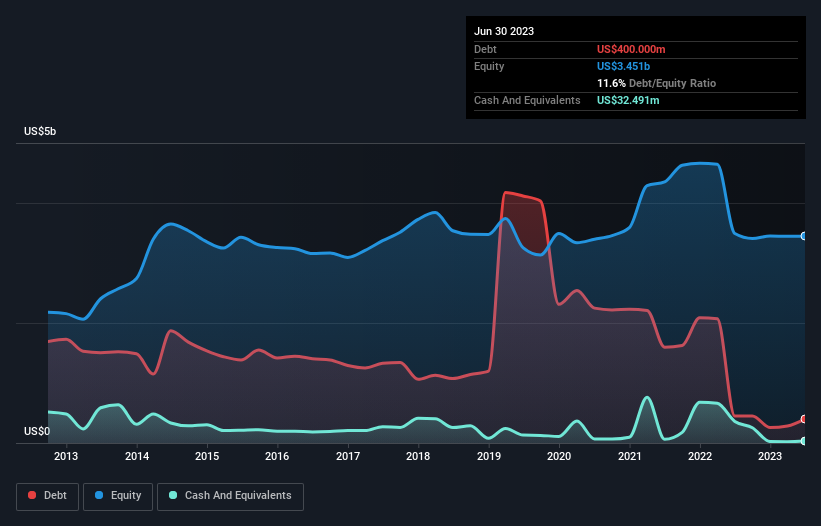The external fund manager backed by Berkshire Hathaway's Charlie Munger, Li Lu, makes no bones about it when he says 'The biggest investment risk is not the volatility of prices, but whether you will suffer a permanent loss of capital.' It's only natural to consider a company's balance sheet when you examine how risky it is, since debt is often involved when a business collapses. As with many other companies Enovis Corporation (NYSE:ENOV) makes use of debt. But the real question is whether this debt is making the company risky.
What Risk Does Debt Bring?
Debt and other liabilities become risky for a business when it cannot easily fulfill those obligations, either with free cash flow or by raising capital at an attractive price. If things get really bad, the lenders can take control of the business. However, a more frequent (but still costly) occurrence is where a company must issue shares at bargain-basement prices, permanently diluting shareholders, just to shore up its balance sheet. Of course, debt can be an important tool in businesses, particularly capital heavy businesses. The first step when considering a company's debt levels is to consider its cash and debt together.
Check out our latest analysis for Enovis
What Is Enovis's Debt?
You can click the graphic below for the historical numbers, but it shows that Enovis had US$400.0m of debt in June 2023, down from US$449.5m, one year before. On the flip side, it has US$32.5m in cash leading to net debt of about US$367.5m.

How Healthy Is Enovis' Balance Sheet?
According to the last reported balance sheet, Enovis had liabilities of US$353.7m due within 12 months, and liabilities of US$639.1m due beyond 12 months. Offsetting this, it had US$32.5m in cash and US$299.0m in receivables that were due within 12 months. So it has liabilities totalling US$661.3m more than its cash and near-term receivables, combined.
This deficit isn't so bad because Enovis is worth US$2.83b, and thus could probably raise enough capital to shore up its balance sheet, if the need arose. However, it is still worthwhile taking a close look at its ability to pay off debt. The balance sheet is clearly the area to focus on when you are analysing debt. But ultimately the future profitability of the business will decide if Enovis can strengthen its balance sheet over time. So if you want to see what the professionals think, you might find this free report on analyst profit forecasts to be interesting.
In the last year Enovis wasn't profitable at an EBIT level, but managed to grow its revenue by 6.4%, to US$1.6b. That rate of growth is a bit slow for our taste, but it takes all types to make a world.
Caveat Emptor
Over the last twelve months Enovis produced an earnings before interest and tax (EBIT) loss. To be specific the EBIT loss came in at US$2.0m. When we look at that and recall the liabilities on its balance sheet, relative to cash, it seems unwise to us for the company to have any debt. Quite frankly we think the balance sheet is far from match-fit, although it could be improved with time. Another cause for caution is that is bled US$106m in negative free cash flow over the last twelve months. So to be blunt we think it is risky. For riskier companies like Enovis I always like to keep an eye on the long term profit and revenue trends. Fortunately, you can click to see our interactive graph of its profit, revenue, and operating cashflow.
When all is said and done, sometimes its easier to focus on companies that don't even need debt. Readers can access a list of growth stocks with zero net debt 100% free, right now.
Valuation is complex, but we're here to simplify it.
Discover if Enovis might be undervalued or overvalued with our detailed analysis, featuring fair value estimates, potential risks, dividends, insider trades, and its financial condition.
Access Free AnalysisHave feedback on this article? Concerned about the content? Get in touch with us directly. Alternatively, email editorial-team (at) simplywallst.com.
This article by Simply Wall St is general in nature. We provide commentary based on historical data and analyst forecasts only using an unbiased methodology and our articles are not intended to be financial advice. It does not constitute a recommendation to buy or sell any stock, and does not take account of your objectives, or your financial situation. We aim to bring you long-term focused analysis driven by fundamental data. Note that our analysis may not factor in the latest price-sensitive company announcements or qualitative material. Simply Wall St has no position in any stocks mentioned.
About NYSE:ENOV
Enovis
Operates as a medical technology company focus on developing clinically differentiated solutions in the United States and internationally.
Undervalued with moderate growth potential.
Similar Companies
Market Insights
Community Narratives




